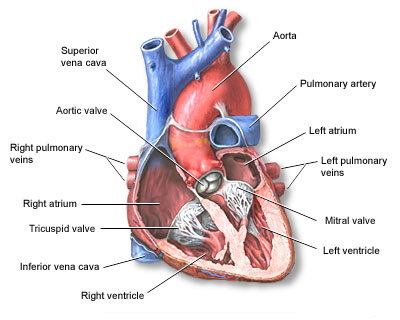Atrial fibrillation or flutter
Content
Causes
Symptoms
Exams and Tests
Treatment
Outlook (Prognosis)
When to Contact a Medical Professional
Prevention
Atrial fibrillation or flutter is a common type of abnormal heartbeat. The heart rhythm is fast and most often irregular.
Causes
When working well, the 4 chambers of the heart contract (squeeze) in an organized way.
Electrical signals direct your heart to pump the right amount of blood for your body's needs. The signals begin in an area called the sinoatrial node (also called the sinus node or SA node).

In atrial fibrillation, the electrical impulse of the heart is not regular. This is because the sinoatrial node no longer controls the heart rhythm.
· Parts of the heart cannot contract in an organized pattern.
· As a result, the heart cannot pump enough blood to meet the body's needs.
In atrial flutter, the ventricles (lower heart chambers) may beat very rapidly, but in a regular pattern.
These problems can affect both men and women. They become more common with increasing age.
Common causes of atrial fibrillation include:
· Alcohol use (especially binge drinking)
· Coronary artery disease
· Heart attack or heart bypass surgery
· Heart failure or an enlarged heart
· Heart valve disease (most often the mitral valve)
· Hypertension
· Medicines
· Overactive thyroid gland (hyperthyroidism)
· Pericarditis
· Sick sinus syndrome
Symptoms
You may not be aware that your heart is not beating in a normal pattern.
Symptoms may start or stop suddenly. This is because atrial fibrillation may stop or start on its own.
Symptoms may include:
· Pulse that feels rapid, racing, pounding, fluttering, irregular, or too slow
· Sensation of feeling the heart beat (palpitations)
· Confusion
· Dizziness, lightheadedness
· Fainting
· Fatigue
· Loss of ability to exercise
· Shortness of breath
Exams and Tests
The health care provider may hear a fast heartbeat while listening to your heart with a stethoscope. Your pulse may feel fast, uneven, or both.
The normal heart rate is 60 to 100 beats per minute. In atrial fibrillation or flutter, the heart rate may be 100 to 175 beats per minute. Blood pressure may be normal or low.
An ECG (a test that records the electrical activity of the heart) may show atrial fibrillation or atrial flutter.
If your abnormal heart rhythm comes and goes, you may need to wear a special monitor to diagnose the problem. The monitor records the heart's rhythms over a period of time.
· Event monitor (3 to 4 weeks)
· Holter monitor (24-hour test)
· Implanted loop recorder (extended monitoring)
Tests to find heart disease may include:
· Echocardiogram (ultrasound imaging of the heart)
· Tests to examine the blood supply of the heart muscle
· Tests to study the heart's electrical system
Treatment
Cardioversion treatment is used to get the heart back into a normal rhythm right away. There are two options for treatment:
· Electric shocks to your heart
· Drugs given through a vein
These treatments may be done as emergency methods, or planned ahead of time.
Daily medicines taken by mouth are used to:
· Slow the irregular heartbeat. These drugs may include beta-blockers, calcium channel blockers, and digoxin.
· Prevent atrial fibrillation from coming back. These drugs work well in many people, but they can have serious side effects. Atrial fibrillation returns in many people, even while they are taking these medicines.
Blood thinners are medicines that are used to reduce the risk of developing a blood clot that travels in the body (and that can cause a stroke, for example). They include heparin, warfarin (Coumadin), apixaban (Eliquis), rivaroxaban (Xarelto), and dabigatran (Pradaxa).
These drugs increase the chance of bleeding, so not everyone can use them. Antiplatelet drugs such as aspirin or clopidogrel may also be prescribed. Your provider will consider your age and other medical problems when deciding which drugs are best.
A procedure called radiofrequency ablation can be used to scar areas in your heart where the heart rhythm problems are triggered. This can prevent the abnormal electrical signals that cause atrial fibrillation or flutter from moving through the heart. You may need a heart pacemaker after this procedure. All people with atrial fibrillation will need to learn how to manage this condition at home.
Outlook (Prognosis)
Treatment can often control this disorder. Many people with atrial fibrillation do very well.
Atrial fibrillation tends to return and get worse. It may come back, even with treatment.
Clots that break off and travel to the brain can cause a stroke.
When to Contact a Medical Professional
Call your provider if you have symptoms of atrial fibrillation or flutter.
Prevention
Talk to your provider about steps to treat conditions that cause atrial fibrillation and flutter. Avoid binge drinking.
Source https://medlineplus.gov/ency/article/000184.htm

